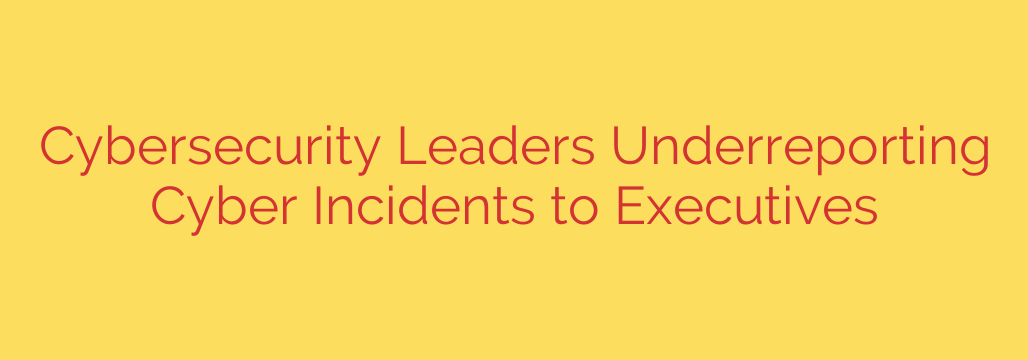
A Dangerous Disconnect: Why Your Board May Be in the Dark About Real Cyber Risks
In today’s digital landscape, cybersecurity is a cornerstone of corporate governance. Executives and board members rely on their security leaders to provide a clear and accurate picture of the organization’s risk posture. However, a troubling communication gap is putting companies in jeopardy. New findings reveal that a significant number of cybersecurity leaders are deliberately underreporting or downplaying cyber incidents when briefing their executive teams.
This disconnect isn’t just a minor communication issue; it’s a critical vulnerability. When the C-suite operates with incomplete or filtered information, it cannot make informed decisions about resource allocation, strategic investments, or risk tolerance. The result is a false sense of security that can shatter the moment a major, unmitigated incident occurs.
The Scope of the Silence
The problem is more widespread than many realize. Recent data indicates that nearly one-third of cybersecurity leaders have admitted to withholding or misrepresenting information about cyber incidents when reporting to their board. This isn’t about hiding minor glitches; it often involves significant security events that leadership needs to be aware of.
But why would the very people hired to protect the company choose to obscure the truth? The reasons are complex and point to deep-seated cultural issues within many organizations.
Fear, Reputation, and a Culture of Blame
The primary driver behind this lack of transparency is fear. Security leaders are concerned about the personal and professional repercussions of reporting bad news. The main reasons cited for underreporting include:
- Fear of Personal Reputational Damage: Nearly 30% of leaders who underreported did so out of concern for their own careers. In a culture where security incidents are seen as personal failures, CISOs may feel pressured to only report successes.
- Protecting the Company’s Reputation: Over 25% were worried about the damage an incident could do to the company’s public image or stock price if the information were to leak.
- Lack of Clear Reporting Guidelines: Around 23% noted that their organization lacks clear guidance on which incidents are “material” enough to require a board-level report, leaving the decision to their subjective judgment.
When security incidents are met with blame instead of being treated as valuable learning opportunities, it naturally encourages a culture of concealment. Leaders who fear being fired for a breach are incentivized to minimize, deflect, or hide the facts.
The Other Side of the Table: Is the Board Ready to Listen?
The responsibility for this communication breakdown doesn’t rest solely with security leaders. There’s a significant challenge on the receiving end as well. A staggering 51% of cybersecurity leaders believe their board members do not fully grasp the severe and persistent cyber risks their organizations face.
This lack of board-level cyber literacy creates a vicious cycle. When CISOs attempt to communicate complex technical risks, their message may be lost in translation. If executives don’t understand the context or potential business impact of a threat, they may dismiss it, leading the CISO to simplify or omit crucial details in future reports just to be heard. This dynamic forces security leaders to speak in terms of simple metrics (e.g., “we blocked X threats”) rather than nuanced business risk.
Actionable Steps to Bridge the Communication Gap
Creating a resilient security posture requires absolute transparency between security teams and the executive board. Hiding or downplaying risks is a losing strategy. Here are four essential steps organizations can take to foster a culture of open and honest security reporting.
Foster a “Blame-Free” Security Culture: Leadership must champion the idea that security incidents are inevitable and should be treated as opportunities for improvement, not grounds for punishment. When a CISO can report a breach without fear of immediate termination, the organization gains invaluable insight needed to strengthen its defenses.
Establish Objective Reporting Thresholds: Remove the ambiguity. Work with security, legal, and executive teams to create a clear, data-driven framework for what constitutes a “material” incident. Define specific triggers for board-level reporting, such as the number of records compromised, the type of data affected, or the potential financial impact.
Translate Technical Data into Business Impact: Security leaders must learn to communicate in the language of the boardroom. Instead of discussing malware strains and firewall rules, frame incidents in terms of business risk: potential financial loss, operational downtime, regulatory fines, and reputational damage. Quantifying risk in this way makes it tangible and actionable for executives.
Invest in Board-Level Cybersecurity Education: The board doesn’t need to become a team of hackers, but its members must have a foundational understanding of modern cyber threats. Regular, high-level briefings from trusted advisors, incident simulations, and workshops can dramatically improve their ability to ask the right questions and properly oversee the organization’s security strategy.
Ultimately, cybersecurity is a shared responsibility. Building a bridge of trust and clear communication between security leaders and the board is not just good practice—it’s essential for survival in an increasingly hostile digital world.
Source: https://www.helpnetsecurity.com/2025/09/29/cyberattacks-frequency-impact-growth/








